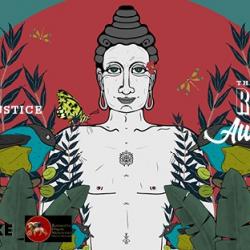These are a few of the topics, essays, and projects you should know about this week.
First, the Two Buddhisms story. I’ve written about this quite a bit and consider Charles Prebish, the man who coined the term, to be a good friend. Today he passed me the link to a new blog post by Suwanda H J Sugunasiri, a Sri Lankan scholar in Canada, who discusses the use of these and other categories. Give it a read. Let me know what you think.
~
Next, Bhante Sujato is launching a project seeking to better define which of the Buddhist texts that have come down to us are most likely to be authentic. This is another area of research close to my heart, so I’m excited to see what comes of it. My current research is focused on reconstructing the ideas of the Buddha (cf. Gombrich’s What the Buddha Thought), so having good reason to privilege certain texts over others could prove to be very helpful.
Some people are skeptical about just how well we can reconstruct “early” Buddhism, but when faced with the evidence of growing textual and archaeological work, this skepticism often begins to shade into conspiracy theory, somewhat like (as Bhante points out) climate change deniers: “we can’t know for sure, therefore doubt it all.” Luckily, the vast majority of scholars focusing on early Buddhism assume “that the main body of soteriological teaching found in the Pali Canon does go back to the Buddha himself.”*
If we try to discover the original meaning of the Buddha’s sermons, we need to know what cultural knowledge and presuppositions he shared with his audience. We must admit, I fear, that we cannot know very much about the Buddha’s interlocutors or about what his audiences were thinking or taking for granted, and to that extent some of what he meant may be lost to us. We may however be slightly better off in this respect than were the authors of the Pali commentaries. Even if we know little of the Buddha’s cultural milieu, in some cases our knowledge of historical linguistics and of parallel (mainly brahminical) texts allows us to know things the commentators did not – as Norman’s work has amply demonstrated.**
Gombrich’s style seems to focus on contextualizing the ideas of early Buddhism vis-a-vis other traditions for which we have evidence in the same timeframe. He then finds the ones that are most “brilliant,” again vis-a-vis what would have been the Buddha’s contemporaries. These include the ethicisation of karma (kamma); removing it from the ritual context of the Brahmins and the physical context of Jainism; his reversal of the connotations of “fire” – which was exalted in Brahmanic culture and again tied to ritual, but used by the Buddha to describe greed, aversion, and delusion.
Speaking historically, if it wasn’t “the Buddha” who came up with these revolutions in thought (and there are countless more examples), then who ever did come up with them would be deserving of the title.
The skeptical retort that perhaps they were composed separately over a period of many decades or centuries just doesn’t make much sense when you sit and read them. At times, there are odd phrases or teachings -and these stand out for just this reason- but as a whole, the teachings do read as having a common voice. This is necessarily a bit subjective, but it’s also inter-subjective in that anyone can sit down and spend time with the nikayas and decide for him/herself. Having done this myself, I find theories about monks creating the Pali texts out of thin air some time after the Buddha -if he ever existed- to be right up there with ideas about faked moon landings and Obama’s birth certificate. Again, while there are inconsistencies, omissions, and additions, these are to be expected in such an ancient tradition. The tricky part, and one of the very interesting ones, imho, is just what Sujato is doing: figuring out just what is likely to be authentic and what isn’t.
~
Third, go read Richard’s excellent article on being a Pro-life, Pro-choice Buddhist in 40 years after Roe. His sentiments run very closely to my own.
First, I must clearly state that personally I believe that taking another person’s life, including that of an unborn person, is simply wrong in any and all circumstances —even in self-defense. I believe that way because killing another person represents an outcome one has hurled him or herself toward through a series of extraordinarily poor decisions that could have been interrupted just about anywhere along the way.
…despite my personal belief that taking someone’s life, including that of the unborn, is always wrong and never without consequence, I will fight to ensure that abortion is kept legal and easily accessed.To impose my personal belief on another person about whom I know nothing about, about whose life challenges I know nothing about, strikes me as a supreme form of righteousness that frankly makes me sick.
~
Finally, is a NY Times article posted over at Shravasti Dhammika‘s blog, Dhamma Musings called Is Universal Metta Possible? The premise of the article is that -contra Buddhism (and Utilitarian philosopher Peter Singer) – love is biological and thus finite, therefore any kind of universal love or goodwill is just folly. Stephen Schettini, the Naked Monk, wrote something very similar recently, stating “I’ve given up on universal love.” Schettini writes:
In my religious days I tried very hard to be a good boy and love everyone. It sounded fine in theory, but the fact was, people annoyed me. Again and again I found myself faced with two bad choices: to deny my feelings and pretend to care, or to accept them and not care at all.
I’m not as cranky as I used to be but still, I can’t imagine a world in which everyone loves each other.
This calls to mind -or should I say, following the NY Times article, “this triggers so many neuron-firings in my brain”- my studies of Philosophy of Mind. Yes, love has biological correlates that can be relatively well-charted and studied. But it also has phenomenological properties – qualia – that cannot, I would argue, be so easily reduced. The arguments from biology simply don’t belong in the realm of moral aspiration in this way. It’s like saying there are always limits to how high a person can count, therefore infinity is a silly concept.
Schettini’s article is very much about being honest with your emotions, which is a very good point. But I think the author of the NY Times piece goes to far. Both are very good reads.
*Gombrich,”Recovering the Buddha’s Message,” in T. Skorupski (ed.) (1990) The Buddhist Forum: Vol. I. London: School of Oriental and African Studies, pp. 5-30.
**Gombrich, “The Buddha’s Book of Genesis,” Indo-Iranian Journal 35 (1992): 159-78.











